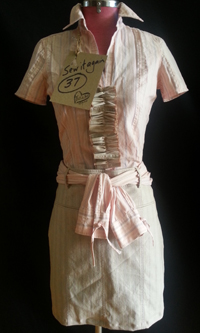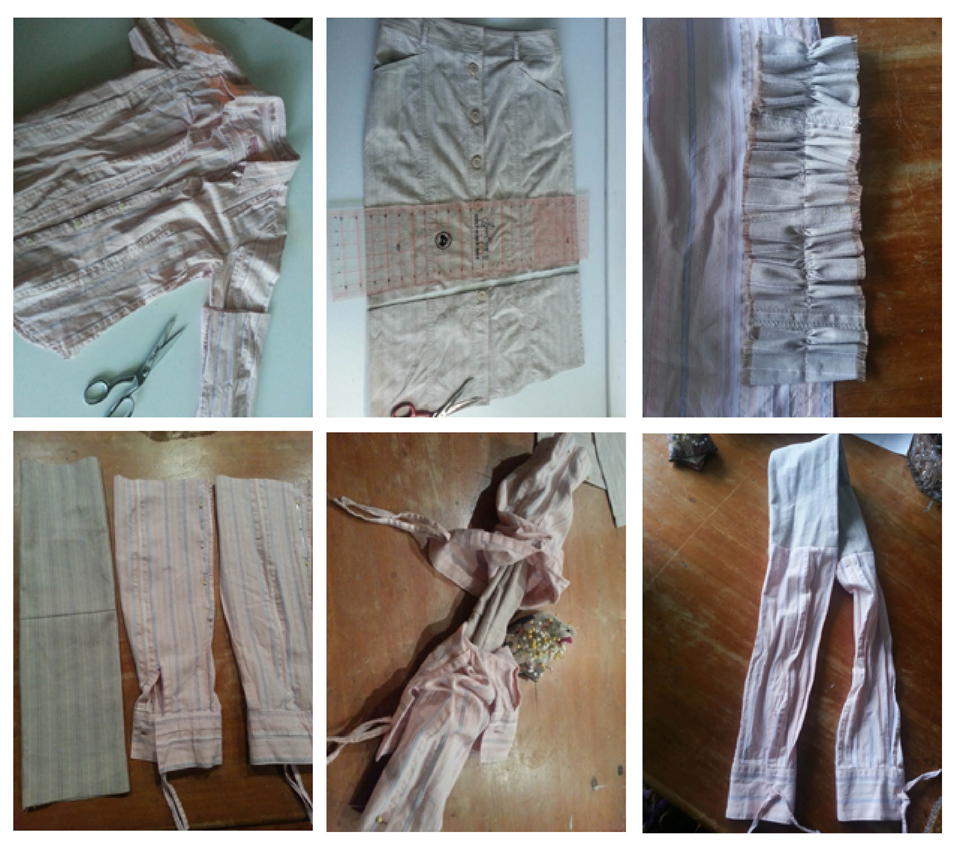 Another day, another outfit – and another amazing new book! The Sustainable Fashion Handbook, by Sandy Black – which was just waiting on the library shelf for me to find.
Another day, another outfit – and another amazing new book! The Sustainable Fashion Handbook, by Sandy Black – which was just waiting on the library shelf for me to find.
Today’s outfit is refashioned from items off the $2 op-shop rack, just one step away from becoming landfill yet barely worn. The shirt sleeves became a belt, extended by an offcut from skirt which helps blend the pink and beige stripe separates.
In her 2014 book, Professor Sandy Black says taken holistically the textile and clothing life cycles consume more energy and water than do the product lifecycles of any other industry except construction or agriculture – with cleaning, drying and ironing of clothes by consumers being especially costly.
“Currently, garments and their component parts are well-travelled commodities with brief lives, often discarded long before they are worn out.” On everyday fashion, Black writes: “Some say everyday clothing is not fashion – but choices we make when we get up in the morning and decide what to wear construct our image both for ourselves and for the outside world.”
Black’s book includes an essay on sustainability, pleasure and fashion politics by Kate Fletcher about the potential for fashion as a tool to promote more connected, engaged lives and thereby improve individual and collective wellbeing rather than fostering empty consumerism.
“The popular view tends to dismiss fashion outright on environmental and ethical grounds because of its (serious) connections with short-termism, material excess and labour abuses, without seeing that the negative repercussions of this categorical stance would hit us hard in other parts of our culture. … The relationship between fashion and sustainability is dynamic and multi-dimensional. For just as fashion without sustainability is ignorant, sustainability without fashion is sad. Each has the potential to bring something vital and different to the other.”
Fletcher writes that perhaps the most intractable issue within fashion and sustainability is the wastefulness, irresponsibility, excess and exploitation endemic to most of the business models and production/consumption systems that have grown up around clothing, expression and identity.
“The sustainability implications of high-volume consumption include its effects on workers, resources, waste levels, air and water quality, and consumers’ physical and psychological health; yet it is still a taboo subject for global brands and high-street retailers who depend on a high throughput of product for financial success. Indeed, high product throughput has come to characterise everyday living in the West, where shopping and spending are for many the leisure activities of choice. It should not be forgotten that fashion cycles and changing trends fan the flames of the consumerist lifestyle; we meet our desire for pleasure, new experiences, status and identity formation through the buying of things – many of them clothes,” Fletcher writes.
And there it is. That’s why perfectly good, well-made, clothing ends up in op shops. The owner’s moved on to the next best thing. Through my Sew it Again campaign this year, I am demonstrating how existing clothing can be recreated into something ‘new’ using simple home-sewing skills, energy and imagination.
This shirt was a beautifully crafted Ted Baker button-down made in Turkey, and the skirt a Wombat cotton with button front. It was mid-calf length, so I chopped it to be above-knee length and made the back into the front. I cropped the sleeves off and turned them into a belt by extending them using skirt off-cuts, and gathered another offcut then added it to embellish the shirt front.
